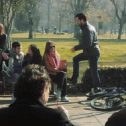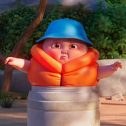"An unexpected occurrence at a Parisian cafe."
At The Cafe is a short film about a man who is sabotaged and framed by his own mirror reflection. One of those brief film gems that deserve to be seen by a large audience, the short was created by five artists using stop motion technique during their first-year studies at France-based Ecole Georges Méliès. The project was inspired by a painting from Gustave Caillebotte, a French artist from the 1800s.
Four characters, two of them presented as separate versions of the same character, external conflicts and particular use of a mirror and offscreen space are the main elements of the short.
Situated in a Parisian cafe in the late 1800s, a mirror is used to show the action taking place in offscreen space. Through non-realistic staging, this mirror soon serves as a narrative tool to split and decouple the main character of the man from his reflection, who starts acting as an antagonist. This in turn puts into question if the mirror is showing offscreen space or not, since the reflection character switches his behavior continuously between an offscreen and onscreen element. The reflection character himself, however, never has a reflection of his own in the mirror, maintaining his status as a character with supernatural qualities.
One shot, no cuts, static camera. These aesthetic choices place an accent on blocking and choreography of characters, in line with films from the early decades of cinema. Visual rhythm is average, handled mostly through motion within the frame and changes in focus. A styled aesthetic is employed for the puppets that strays away from Caillebotte’s original painting. The expressiveness of the puppets help greatly in transmitting conflict.
What makes At The Cafe work so well? Highly creative script and original use of stop motion animation, abundant surprises, strong conflicts and fun experimentation with characters, non-realistic staging and offscreen space. The reflection character breaking the fourth wall and addressing the audience at the end adds to the playfulness and furthers the idea that the directors are ultimately having fun with audience’s perceptions.
Link
Original painting by Gustave Caillebotte
If you participated in the film and would like to see your portfolio link added to this page, please send it via our contact form. Thank you.



















Recent Comments